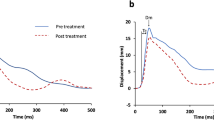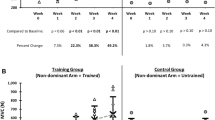Summary
Changes in strength and size of the elbow flexor muscles have been compared during six weeks of isometric strength training in six male and six female subjects. Isometric training of one arm resulted in a significant increase in isometric force (14.5±5.1%, mean±SD,n = 12). No differences were seen in the response of male and female subjects. The extent of the change was similar to that reported for training studies of other muscles, thus refuting the suggestion that the elbow flexors may be especially amenable to training. Biceps and brachialis cross-sectional area (CSA) was measured from mid-upper arm X-ray computerized tomography before and after training. Muscles increased in area (5.4±3.8%) but this was smaller than, and not correlated with, the increase in strength. The main change in the first six weeks of strength training was therefore an increase in the force generated per unit cross-sectional area of muscle. The arrangement of fibres in the biceps is nearly parallel to the action of the muscle and it is argued that the increase in force per unit cross-sectional area is unlikely to be due to changes in the pennation of the muscle fibres as has been suggested for other muscles.
Similar content being viewed by others
References
Chapman SJ, Edwards RHT, Grindrod SR, Jones DA (1984) Cross-sectional area and force production of the quadriceps. J Physiol 353:53P
Dons B, Bollerup K, Bonde F (1979) The effect of weight lifting exercise related to muscle fibre composition and muscle CSA in humans. Eur J Appl Physiol 40:95–106
Grindrod S, Tofts P, Edwards RHT (1983) Investigation of human skeletal muscle structure and composition by X-ray computerized tomography. Eur J Clin Invest 13:465–468
Grindrod S, Round JM, Rutherford OM (1987) Type 2 fibre composition and force per cross-sectional area in the human quadriceps. J Physiol 390:154P
Ikai M, Fukunaga T (1968) Calculation of muscle strength per unit cross-sectional area of human muscle by means of ultrasonic measurement. Int Z Angew Physiol 26:26–32
Ikai M, Fukunaga T (1970) A study on training effect on strength per unit cross-sectional area of muscle by means of ultrasonic measurement. Int Z Angew Physiol 28:173–180
Jones DA, Newham DJ (1985) A simple apparatus for eccentric or concentric exercise of the biceps. J Physiol 365:10P
Jones DA, Rutherford OM (1987) Human muscle strength training: the effects of three different training regimes and the nature of the resultant changes. J Physiol 391:1–11
Komi PV, Viitasalo J, Raumara R, Vihko V (1978) Effect of isometric strength training on mechanical and metabolic aspects of muscle function. Eur J Appl Physiol 40:45–55
Moritani T, De Vries HA (1979) Reexamination of the relationship between surface IEMG and force of isometric contractions. Am J Clin Med 57:263–277
Rutherford OM, Jones DA, Newham DJ (1986) Clinical and experimental application of the percutaneous twitch superimposition technique for the study of human muscle activation. J Neurol Neurosurg Psychiat 49:1288–1291
Rutherford OM, Jones DA (1986) The role of learning and coordination in strength training. Eur J Appl Physiol 55:100–105
Sale DG, MacDougall JD (1984) Isokinetic strength in weight-trainers. Eur J Appl Physiol 53:128–132
Thorstensson A, Karlsson J, Viitasalo JHT, Luhtanen P, Komi PV (1976) Effect of strength training om EMG of human skeletal muscle. Acta Physiol Scand 98:232–236
Young A (1984) The relative isometric strength of Type 1 and Type 2 muscle fibres in the human quadriceps. Clin Physiol 4:23–32
Young A, Stokes M, Crowe M (1984) Size and strength of the quadriceps muscle in young and old women. Eur J Clin Invest 14:282–287
Young A, Stokes M, Crowe M (1985) The size and strength of the quadriceps muscles of old and young men. Clin Physiol 5:145–154
Author information
Authors and Affiliations
Rights and permissions
About this article
Cite this article
Davies, J., Parker, D.F., Rutherford, O.M. et al. Changes in strength and cross sectional area of the elbow flexors as a result of isometric strength training. Europ. J. Appl. Physiol. 57, 667–670 (1988). https://doi.org/10.1007/BF01075986
Accepted:
Issue Date:
DOI: https://doi.org/10.1007/BF01075986




